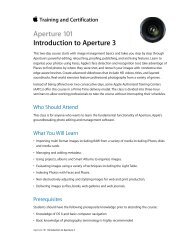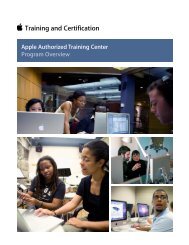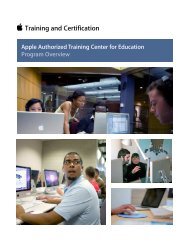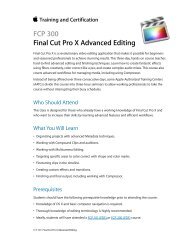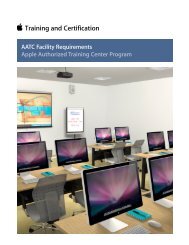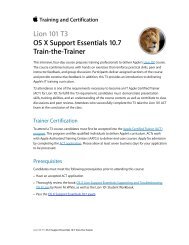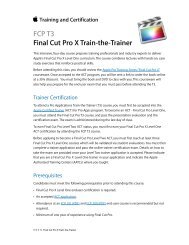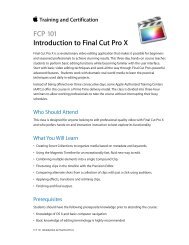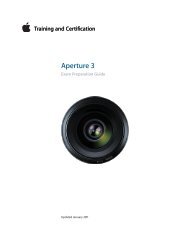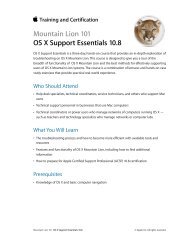OS X Support Essentials 10.8 - Training - Apple
OS X Support Essentials 10.8 - Training - Apple
OS X Support Essentials 10.8 - Training - Apple
You also want an ePaper? Increase the reach of your titles
YUMPU automatically turns print PDFs into web optimized ePapers that Google loves.
<strong>OS</strong> X <strong>Support</strong> <strong>Essentials</strong> <strong>10.8</strong> Exam Preparation Guide<br />
• Describe the advanced firewall settings in <strong>OS</strong> X.<br />
Lesson Twenty-five review questions<br />
After completing Lesson Twenty-five, you should be able to answer the<br />
following questions.<br />
1. What is the relationship between clients and servers as it<br />
relates to network service access?<br />
2. What is the relationship between a network service and a<br />
network port?<br />
3. What is the primary interface for configuring network service<br />
applications?<br />
4. Which five network file services can you connect to from the<br />
“Connect to Server” dialog in the Finder?<br />
5. How are items inside the Network folder in the Finder<br />
populated?<br />
6. Which two methods can be used to automatically connect a<br />
network share?<br />
7. What are three common troubleshooting techniques for<br />
issues involving failure to connect to network services?<br />
8. How can you verify that a specific network service is available<br />
from a service provider?<br />
9. What are some known issues that arise when connecting to<br />
network file services?<br />
Answers<br />
1. Client software is used to access network services provided<br />
by server software. The connection is established using a<br />
common network protocol known by both the client and<br />
server software. Thus, the client and server software can be<br />
from different sources.<br />
2. Network services are established using a common network<br />
protocol. The protocol specifies which TCP or UDP port<br />
number is used for communications.<br />
3. The Mail, Contacts & Calendars preference in System<br />
Preferences is the primary interface in <strong>OS</strong> X for configuring<br />
built-in network applications.<br />
4. From the “Connect to Server” dialog in the Finder, you can<br />
connect to:<br />
• <strong>Apple</strong> File Protocol (AFP)<br />
• Server Message Blocks/Common Internet File System (SMB/<br />
CIFS)<br />
• Network File System (NFS)<br />
• Web-based Distributed Authoring and Versioning<br />
(WebDAV)<br />
41



